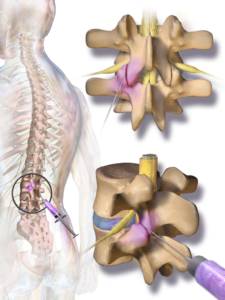Treatment: Lumbar Transforaminal Epidural Steroid Injections (TFESIs)
Background:
Lumbar TFESIs are performed for the treatment of low back and/or leg pain due to spinal conditions resulting in inflammation and pressure on spinal nerves. These conditions can include disc herniations, stenosis, and/or radiculopathy(sciatica). During TFESIs, the medication is placed in the opening (foramen) where the nerve exits the spine. Two types of medication are usually injected, a corticosteroid (steroid) and a local anesthetic or numbing medication. The injected spinal level will be determined by your physician based upon your clinical evaluation and diagnostic testing.
Precautions:
The procedure requires use of x-ray to precisely place the needle. Therefore, if you are pregnant, please inform your physician prior to the procedure. The amount of x-ray exposure is within recommended safe limits for adults, but can be hazardous to the developing fetus.
If you are on blood thinners or anticoagulants, please notify your physician. Special precautions or medication adjustments may be deemed necessary. However, do not stop your medication without consulting with your physician.
If you are a diabetic and take medications, notify your physician as medication adjustments may be necessary. Your blood sugars will likely temporarily increase following the procedure due to the administration of a corticosteroid medication.
You will require a driver after the procedure, as it may be unsafe to operate a vehicle.
Notify your physician of any allergies you may have.
Before the procedure:
During the procedure:
You will be placed face down onto a special table for the procedure. After cleansing the skin, a drape will be applied. The medications will be placed in syringes, ensuring sterility. The x-ray machine will be maneuvered to a satisfactory position. A needle will be placed precisely to the target area, utilizing multiple views for safety. After satisfactory placement of the needle, contrast dye is injected for confirmation and additional safety. Occasionally, needle adjustments must be made. The medication is injected after satisfactory flow of the contrast dye. Multiple pictures are taken and saved, and then the needle is removed.
After the procedure:
Your skin will be cleansed and a bandage applied as necessary. You will be taken to an observation area and monitored for any adverse reactions, which are very rare. Your usual pain will be re-assessed and documented. You will be given a pain diary to further document your pain upon discharge from the center. It is extremely important for your treatment that you complete and return the pain diary.
Side effects or complications:
Side effects are generally minimal and can include increased discomfort, local bruising, headache, nausea, fainting or dizziness. These symptoms are usually short-lived and will resolve themselves. More severe complications are rare such as infection, allergic reaction, or nerve injury.
If you have any questions or concerns, please contact us at (610) 954-9400.


